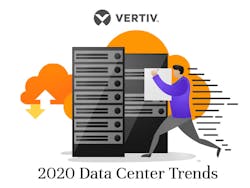Proliferation of Hybrid Computing Models Among 2020 Data Center Trends
Moving into 2020, organizations increasingly will forego the enterprise-or-cloud debate that dominated C-level conversations in recent years in favor of hybrid architectures that incorporate public and private cloud models and edge assets around a reconfigured core. This evolving approach to managing data and computing resources is one of five emerging 2020 data center trends identified by experts from Vertiv, a provider of IT infrastructure and continuity solutions.
The trending hybrid architectures will allow organizations to maintain control of sensitive data while still meeting demands for more capacity and increased computing capabilities closer to the consumer. As connectivity and availability become conjoined concepts in this new data ecosystem, an increasing premium will be placed on seamless communication from core to cloud to edge.
Additional trends include:
• Speed of deployment as the new arms race: As capabilities across technologies and systems flatten out, data center and IT managers will increasingly turn to other criteria for selecting equipment. Cost is always a separator, but more and more the decision will depend on how quickly assets can be deployed. When all other factors are close, any advantage in speed of deployment and activation can be the determining factor. This is especially true as computing continues to migrate to the edge in today’s distributed networks, where delivery delays mean lack of service — and revenue.
• Average rack density remains static … but: Although average rack density is likely to reflect marginal increases at best, the surge in advanced applications and workloads related to artificial intelligence (AI), such as machine learning and deep learning, will make pockets of high-performance computing necessary and more common. Vertiv experts anticipate early activity in this space in the areas of defense, advanced analytics, and manufacturing in 2020, laying the foundation for more widespread adoption in 2021 and beyond. Although these racks so far represent a miniscule percentage of total racks, they nevertheless can present unfamiliar power and cooling challenges that must be addressed. The increasing interest in direct liquid cooling is a response to high-performance computing demands.
• Batteries pay it forward: Lithium-ion batteries hold a significant share of the UPS battery market. That share is growing and starting to extend to edge sites, where the smaller footprint and reduced maintenance requirements are a natural fit. The next step is leveraging the flexibility of lithium-ion and other emerging battery alternatives, such as thin plate pure lead (TPPL), to offset their costs. As 2020 progresses, more organizations will start to sell the stored energy in these batteries back to the utility to help with grid stabilization and peak shaving.
• Global cross-pollination: The United States has been the epicenter of the digital universe and this generation of data center development, but innovation happens everywhere. A parallel digital ecosystem with notable differences is emerging in China. Data centers across Europe and in other Asian and South Pacific markets, such as Australia, New Zealand, and Singapore, are evolving and diverging from traditional practices based on specific regional issues related to data privacy and controls and sustainability. For example, GDPR compliance is driving hard decisions around data management around the world. Those issues, and more attention to environmental impacts, are leading to new thinking about hybrid architectures and the value of on-premise computing and data storage. In China, some data centers have been running 240VDC power into manufacturer-modified servers to improve efficiency and reduce costs.
For more information, visit www.vertiv.com.
